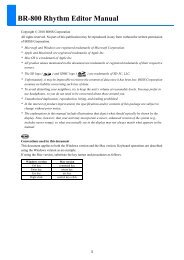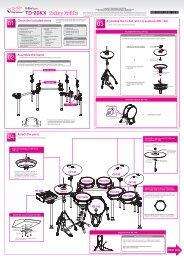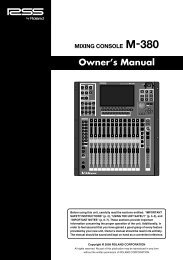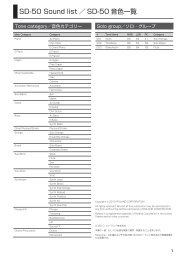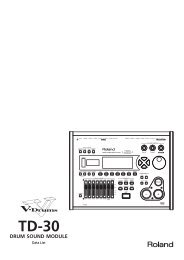GAIA Exploring Sound (PDF) - Roland Corporation Australia
GAIA Exploring Sound (PDF) - Roland Corporation Australia
GAIA Exploring Sound (PDF) - Roland Corporation Australia
You also want an ePaper? Increase the reach of your titles
YUMPU automatically turns print PDFs into web optimized ePapers that Google loves.
So now you can choose which method you prefer. Hardware or<br />
software. Either way you can turn on a delay signal.<br />
What is Delay?<br />
We’ve all seen movies where someone might yell out to the<br />
mountains. They say; “hello,” and some time later they hear their<br />
voice return; “hello.” The sound might not be as clear, but is very<br />
definitely an echo of their voice.<br />
This time-delay occurs because sound travels at a finite speed. It<br />
takes some time for the sound of the voice to reach the first<br />
mountain, and then the same amount of time to bounce back.<br />
This is what we refer to as Delay in the <strong>GAIA</strong>. You play a note, and<br />
after a predetermined time-delay you will hear that note played<br />
again.<br />
So, back in the 1980s, how was that effect achieved?<br />
Actually, prior to that, musicians would use what they called a<br />
tape delay, like the very famous <strong>Roland</strong> RE-201.<br />
Figure 10.4 <strong>Roland</strong> RE-201<br />
This device really was an elaborate tape recorder. It had one<br />
record head, and several playback heads. A loop of magnetic<br />
tape would pass the record head, receiving the signal. It would<br />
then travel on to the first playback head.<br />
Depending upon how fast the tape was moving this first playback<br />
head would replay the signal after a small time-delay. The result<br />
was much the same as the guy in the mountains.<br />
However, then the tape would pass more playback heads, each<br />
with a slightly greater delay caused by the tape passing them in<br />
succession. As a result the Delay would be repeated. A sort of;<br />
“hello,” “hello,” hello,” “hello” effect.<br />
Times Change<br />
As time moved on it became obvious that the Tape Delay concept<br />
wasn’t going to last. The tapes would wear out, degrading the<br />
sound. Being a mechanical device the parts would need constant<br />
maintenance.<br />
So a better solution was needed, preferably purely electronic.<br />
One of the earliest solutions was to take advantage of what was<br />
called a “bucket brigade” device.<br />
Imagine a fireman trying to put out a fire. Let’s say that his water<br />
outlet is 15 meters from the blaze. Of course, he could just fill the<br />
124




